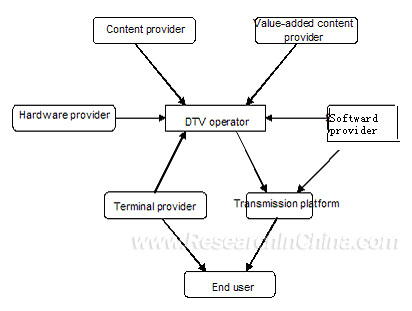Digital Television (DTV) is a new type of broadcasting technology that transmits television programs in “data bits”. Compared with the analog television, DTV enjoys overwhelming superiorities. It has become an irreversible trend both at home and abroad that analog television will be digitized. China has set the timetable to implement DTV, that is, it plans to comprehensively deploy DTV before 2008 and phase out analog television by 2015.
The State Administration of Radio Film and Television (SARFT), the major television regulatory body in China, has always positively promoted the development of DTV. In 2001, SARFT released The Tenth Five-year Program of Radio Film and Television Technology and constituted The Timetable of CATV to DTV. SARFT is also considering inviting domestic investors who have capitals, resources and programs including private capital investment, to join the operation of pay channels. In addition, SARFT has won support from the tax department who has promised some tax-reducing or remitting policies on DTV investments.
All sectors in the DTV industry chain are interdependent and playing different roles. The upstream products can only produce value when they reach the end users through the industry chain. Any interruption of the industry chain will cause failure for the upstream products to reach end users, thus produce no value. Balanced development and eliminating bottleneck are the right ways to pursue a benign cycle of the industry chain.
From the point of view on competition strategy, upstream and downstream enterprises in the industry chain are both rivals and partners. They need to cooperate smoothly as well as bring their strengths into full play to gain profits. When a bottleneck occurs in the industry chain, there might be a substitute to make sure the chain maintains complete. Currently many people intend to unify the industry chain to maximize profits. This is obviously impractical.
Currently the DTV industry in China is still in an initiation stage, and the industry chain is gradually shaping. A bottleneck in the chain will obstruct the development of the whole industry.
DTV Industry Chain

Besides digital CATV, DTV also includes In-Building TV, Mobile TV and Internet Protocol TV (IPTV).
In-Building TV is a new type of public media rising in big cities like Beijing, Shanghai, Guangzhou and Shenzhen. In-Building TV ads are mainly high-grade and stylish commercials, entertainment information and public service advertisement. Industries that advertise in In-Building TV are mainly of telecommunications, banking, mobile phone, automobile, cosmetic and commodities, among which telecoms, mobile phone and automobile commercials account for 10 percent of the total.
Mobile TV is initially introduced by Singapore. In 2002, Shanghai launched its mobile TV system and related services in its bus system and became the second city in the world to establish a mobile TV system. May 2004 saw successful trial broadcasting of mobile TV in Beijing. Currently, citizens in Shanghai, Beijing, Guangzhou, Wuhan, Changchun and Nanjing can watch mobile TV on buses.
IPTV, incorporating Internet, multi-media and communications technologies, is a new type of technology based on broadband CATV network which provides various interactive services including digital television to family users. There are two types of IPTV operators in China: traditional broadcast and television enterprises such as CCTV and Shanghai Media & Entertainment Group, and telecom operators such as China Telecom and CNC. IPTV business in China is currently limited to proving television services such as live broadcasting and on-demand broadcasting, and the programs are still based on conventional television video resources. The key to the future development of IPTV is the operation pattern.
Cities like Beijing, Shanghai, Qingdao, Foshan, Hangzhou, Taiyuan and Suzhou are earlier in developing IPTV and have established their respective IPTV systems to a certain scale. These cases are worth learning.
While the government is vigorously promoting the development of DTV, there are some problems existed in the industry, such as delay of standardization,, difficulty of network integration , lack of terminals, immaturity of market, deficiency of contents, old TV-watching habits, lack of pricing standards, yet-to-be-improved core technology, faultiness of DTV industry chain, immature operation pattern and system problems. All these affect the development of DTV in China.
Future DTV technology will be oriented to flat and large-scale TVs with high definition and information-oriented. With a large consumer market and excellent investment environment, DTV has a bright future in China.
|



